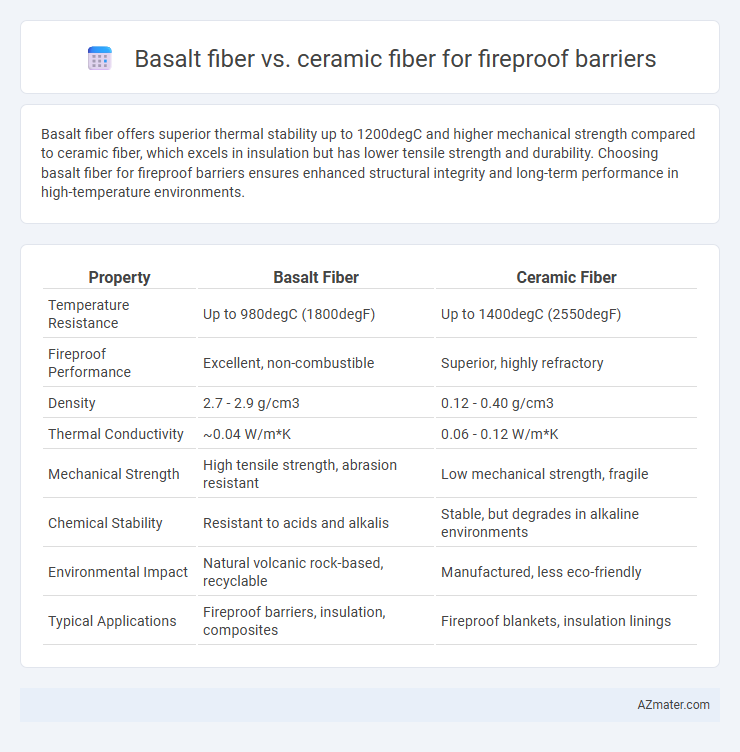Basalt fiber offers superior thermal stability up to 1200degC and higher mechanical strength compared to ceramic fiber, which excels in insulation but has lower tensile strength and durability. Choosing basalt fiber for fireproof barriers ensures enhanced structural integrity and long-term performance in high-temperature environments.
Table of Comparison
| Property | Basalt Fiber | Ceramic Fiber |
|---|---|---|
| Temperature Resistance | Up to 980degC (1800degF) | Up to 1400degC (2550degF) |
| Fireproof Performance | Excellent, non-combustible | Superior, highly refractory |
| Density | 2.7 - 2.9 g/cm3 | 0.12 - 0.40 g/cm3 |
| Thermal Conductivity | ~0.04 W/m*K | 0.06 - 0.12 W/m*K |
| Mechanical Strength | High tensile strength, abrasion resistant | Low mechanical strength, fragile |
| Chemical Stability | Resistant to acids and alkalis | Stable, but degrades in alkaline environments |
| Environmental Impact | Natural volcanic rock-based, recyclable | Manufactured, less eco-friendly |
| Typical Applications | Fireproof barriers, insulation, composites | Fireproof blankets, insulation linings |
Introduction to Basalt Fiber and Ceramic Fiber
Basalt fiber, derived from volcanic basalt rock, offers high tensile strength, excellent thermal stability, and resistance to chemical corrosion, making it suitable for fireproof barriers. Ceramic fiber, composed primarily of alumina and silica, provides superior insulation, withstands extremely high temperatures, and exhibits low thermal conductivity, ideal for fire protection applications. Both fibers excel in fireproofing but differ in composition, temperature resistance, and mechanical properties, influencing their selection based on specific fire barrier requirements.
Composition and Manufacturing Processes
Basalt fiber is produced by melting natural basalt rock at temperatures around 1,400degC and then extruding it into fine fibers, resulting in a material composed primarily of silicon dioxide (SiO2), aluminum oxide (Al2O3), and iron oxide (Fe2O3). Ceramic fibers, on the other hand, are manufactured by blending alumina (Al2O3) and silica (SiO2) in various ratios, followed by high-temperature melting and fiberizing through blowing or spinning processes, yielding fibers with high alumina content for superior thermal resistance. The distinct raw materials and melting technologies lead to basalt fibers offering excellent mechanical strength and chemical stability, while ceramic fibers provide higher temperature thresholds critical for advanced fireproof barriers.
Thermal Resistance Comparison
Basalt fiber exhibits superior thermal resistance compared to ceramic fiber, withstanding continuous temperatures up to 982degC (1800degF) while ceramic fiber typically endures up to 1260degC (2300degF) but degrades faster under thermal cycling. Basalt fiber maintains structural integrity and resists thermal shock due to its crystalline structure, making it ideal for fireproof barriers exposed to fluctuating temperatures. Ceramic fiber offers higher maximum temperature tolerance but can be more brittle and less durable under mechanical stress in fireproof applications.
Fireproof Performance Ratings
Basalt fiber demonstrates superior fireproof performance ratings, withstanding temperatures up to 1200degC without significant degradation, making it ideal for high-temperature insulation and fireproof barriers. Ceramic fiber, while also effective, typically endures up to 1260degC but is more brittle and prone to shrinkage under prolonged heat exposure. The durability and thermal stability of basalt fiber often result in longer-lasting fireproof barriers compared to ceramic fiber in industrial applications.
Mechanical Strength and Durability
Basalt fiber offers superior mechanical strength compared to ceramic fiber, with tensile strengths typically ranging from 2.8 to 3.5 GPa, making it highly resistant to impact and structural deformation under fire conditions. Ceramic fiber, while excellent in thermal insulation, tends to be more brittle and less durable under mechanical stress, often leading to cracking or fragmentation over time. Basalt fiber's enhanced durability and resistance to chemical corrosion provide a longer-lasting fireproof barrier in high-stress environments.
Chemical and Corrosion Resistance
Basalt fiber exhibits superior chemical resistance against acids, alkalis, and solvents, making it highly effective as a fireproof barrier in harsh environments. Ceramic fiber offers excellent resistance to high-temperature oxidation but can be more vulnerable to alkaline corrosion and chemical attack. Both fibers provide strong fireproofing capabilities, but basalt fiber's enhanced durability in corrosive conditions ensures longer performance in chemically aggressive settings.
Environmental Impact and Sustainability
Basalt fiber offers superior environmental benefits compared to ceramic fiber due to its natural origin from volcanic rock and lower energy-intensive production process, resulting in reduced carbon emissions and minimal waste. Ceramic fiber production involves high-temperature kilns and the use of raw materials like alumina and silica, which contribute to greater environmental degradation and non-biodegradable waste. Basalt fiber's recyclability and longer lifespan further enhance sustainability, making it a preferable choice for eco-friendly fireproof barriers.
Cost Comparison: Basalt vs Ceramic Fiber
Basalt fiber offers a cost-effective solution for fireproof barriers, typically priced lower than ceramic fiber while providing comparable thermal resistance up to 1200degC. Ceramic fiber tends to have higher initial costs due to its superior insulating properties and higher melting point near 1425degC. Maintenance expenses are generally lower for basalt fiber, given its enhanced durability and resistance to chemical degradation compared to ceramic fiber.
Installation and Maintenance Requirements
Basalt fiber offers easier installation due to its flexibility and compatibility with standard handling tools, while ceramic fiber requires more careful handling to avoid fiber breakage and dust generation. Maintenance of basalt fiber fireproof barriers is generally lower because of their higher chemical stability and resistance to moisture, reducing the need for frequent repairs or replacements; ceramic fiber, being more fragile and susceptible to damage from environmental factors, demands more routine inspections and potential maintenance. Both materials require proper personal protective equipment during installation, but basalt fiber's durability translates to longer-lasting fireproof barriers with less ongoing upkeep.
Best Applications for Fireproof Barriers
Basalt fiber offers superior thermal stability up to 900degC with excellent mechanical strength, making it ideal for fireproof barriers in industrial settings such as foundries, power plants, and heavy machinery insulation. Ceramic fiber withstands higher temperatures exceeding 1400degC, providing excellent thermal insulation and is best suited for furnace linings, kilns, and high-temperature processing equipment. Choosing between basalt and ceramic fiber depends on the specific fireproof barrier requirements, balancing maximum temperature resistance with mechanical durability and environmental exposure.

Infographic: Basalt fiber vs Ceramic fiber for fireproof barrier
 azmater.com
azmater.com